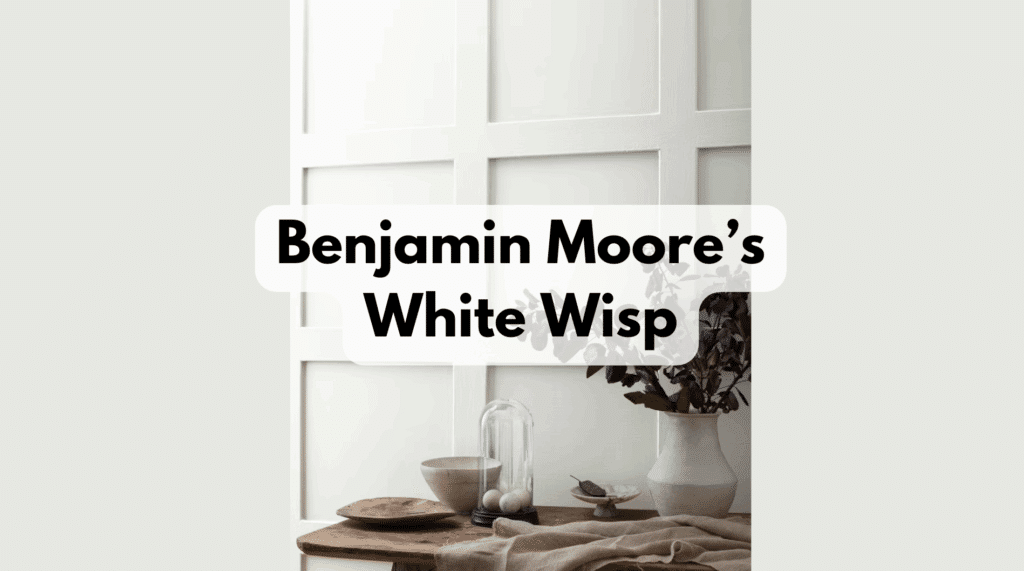Are you looking for the perfect white paint that feels warm but not too yellow? Tired of those cold, sterile whites that make your home feel more like a hospital than a cozy space?
Benjamin Moore’s White Wisp (OC-54) might be just what you need. It’s a soft, airy off-white that brings comfort and calm without feeling boring or flat.
In this article, I’ll walk you through everything you should know about White Wisp. You’ll learn about its subtle undertones, how it changes in different lighting, and what colors it pairs best with.
I’ll also share the rooms where it truly shines and how it compares to other popular white paints. As an interior designer with over 10 years of experience, I’ve used White Wisp in many projects.
I’ve seen how it can warm up a space without feeling too creamy or dull. It’s clean, soft, and easy to live with.
Whether you’re painting one room or your whole house, this guide will help you decide if White Wisp is the right pick. Let’s take a closer look at what makes this color so special.
Why White Wisp (OC-54) Is the Perfect Choice for Your Space?

White Wisp (OC-54) isn’t just another white paint. It’s soft and gentle, with a touch of warmth that makes any room feel cozy and calm.
I often recommend it to people who want a white that feels fresh but not too bright or cold.
What makes White Wisp special is how it changes with the light. In the morning, it can look almost like a clean white.
By evening, its warm undertones come out more. It looks good in both bright and low-light rooms. Unlike some whites that turn gray or dull in shadow, White Wisp stays clear and soft.
It also works well with many styles, from modern to traditional. With a light reflectance value of around 74, it brightens rooms without being too harsh.
The Rich Undertones of White Wisp (OC-54)
White Wisp (OC-54) has soft undertones that give it a warm, rich look. These undertones add depth and make the color feel calm and balanced.
Understanding them can help you use this paint the right way in your space. The main undertone is a light greige—a mix of gray and beige.
This gives White Wisp its warmth, but it never feels yellow. In some lighting, you might notice a tiny hint of blue or green.
These cool hints are very faint but help keep the color from feeling too warm. What makes White Wisp special is how steady it stays in different lighting.
In cool, north-facing rooms, it still feels soft and warm. In sunny, south-facing rooms, it doesn’t shift to yellow like some off-whites do.
This balance makes it easy to use in any room. It won’t clash with other colors or decor. Instead, it creates a gentle, clean background that brings out the best in your furniture and accents.
The Psychology of White Wisp (OC-54)
Colors can change how we feel, and White Wisp is no different. This soft off-white brings calm and peace into a room.
It doesn’t have the sharpness of pure white, which helps make a space feel more cozy and relaxed. The gentle warmth in White Wisp makes rooms feel welcoming.
Many guests feel at ease in a space painted with this color, even if they don’t know why. It creates a soft background that feels open and clean without being cold.
Rooms painted in White Wisp often feel larger and more peaceful. It’s warm but not too much, and it feels timeless instead of trendy. In home offices, clients say it helps them stay focused without feeling bored.
It’s gentle on the eyes, even after a full day. White Wisp also adds a quiet sense of style that plain white often doesn’t.
Where Is White Wisp (OC-54) Best Used in An Interior?
White Wisp (OC-54) is a soft, versatile off-white that works well in many areas of the home. Its balanced warmth and subtle undertones make it a great choice for both bright and low-light spaces.
These are the best places to use it:
- Living rooms
- Kitchens
- Bedrooms
- Bathrooms
- Home offices
- Hallways
What kind of floors would look best with White Wisp (OC-54)?
- Medium-toned wood floors
- Dark hardwood floors (like walnut or espresso)
- Light natural wood (like pine or ash)
- Gray-toned wood or vinyl planks
- Natural stone (like travertine or limestone)
- White marble with warm veining
- Light to medium gray tile
Top Color Combinations with White Wisp (OC-54)
White Wisp’s versatility makes it a perfect partner for many other colors. The following combinations will help you create a cohesive color scheme throughout your home.
Each pairing brings out different aspects of White Wisp’s complex undertones while creating spaces that feel intentionally designed.
1. Hale Navy (HC-154)

This deep, rich navy adds bold contrast when paired with White Wisp. The combination feels both nautical and refined, bringing depth and style to any space. Hale Navy stands out beautifully without overwhelming the room.
Try using Hale Navy on built-ins, cabinets, or furniture, with White Wisp on the surrounding walls. The result is a clean, tailored look that feels timeless and polished.
This pairing works especially well in living rooms, dining areas, and home offices where you want a touch of wordiness with classic appeal.
2. Gray Owl (OC-52)

Gray Owl is a light gray with soft green undertones that pairs gently with White Wisp. Together, they create a calm and relaxed feel that works well in many spaces.
The subtle contrast adds just enough interest without being too bold. Use White Wisp on the main walls to keep things bright and clean.
Then, use Gray Owl on an accent wall or in a nearby room. This pairing flows nicely, especially in open floor plans where you want smooth transitions and a unified look.
It’s a simple yet stylish way to add depth and softness.
3. Black Iron (2120-20)

For a bold and stylish look, pair White Wisp with Black Iron.
This deep, soft black adds a strong contrast that grabs attention without feeling too sharp or cold. The richness of Black Iron helps ground the space, while White Wisp keeps it light and open.
Use Black Iron on window and door trim, interior doors, or even select built-ins and accent furniture. When placed against White Wisp walls, it creates a look that feels both modern and timeless.
This pairing works well in entryways, kitchens, or living rooms where you want a bit of drama with a clean, classic feel. It’s a perfect balance of light and dark, soft and bold.
4. Edgecomb Gray (HC-173)

This light beige works perfectly with White Wisp to create a soft and seamless look. Both colors have gentle undertones, so they blend naturally without sharp contrast.
Use Edgecomb Gray on lower walls and White Wisp above for a simple two-tone style. You can also use Edgecomb Gray in nearby rooms to keep a smooth, connected feel throughout your home.
This pairing adds quiet depth while still feeling bright and open. It’s a great way to keep your space calm, cozy, and pulled together.
5. Boothbay Gray (HC-165)

Boothbay Gray is a soft blue-gray that pairs beautifully with White Wisp. Together, they create a calm, airy feel that hints at coastal style without going overboard.
The cool tones in Boothbay Gray bring out the gentle warmth in White Wisp, creating a fresh and balanced look. Use Boothbay Gray on accent furniture, kitchen islands, or bathroom vanities. Keep White Wisp on the walls to maintain a light, open feel.
This combo adds personality and beauty while staying soft and timeless.
6. Revere Pewter (HC-172)

This classic greige pairs beautifully with White Wisp. Both colors have similar undertones, which helps them blend naturally together.
Revere Pewter adds more depth, giving the space a grounded and cozy feel. Use Revere Pewter on the walls to create a soft, warm backdrop. Then, use White Wisp for the trim and ceilings.
This creates a subtle contrast that gently highlights architectural details without feeling too bold. It’s a timeless and balanced combination that works in many styles.
7. Cloud White (OC-130)

For a soft, tone-on-tone look, pair White Wisp with the slightly brighter Cloud White. Both colors share a similar warmth, which helps the space feel calm and easy on the eyes.
Use Cloud White on the trim, ceilings, and woodwork, while White Wisp covers the main walls. The gentle contrast adds just enough difference to define the space without being bold.
This pairing is perfect for creating a clean, stylish look that feels smooth and seamless. It works well in any room where you want a quiet, polished finish.
8. Kendall Charcoal (HC-166)

This rich, deep gray creates a wordly and grounded palette when paired with White Wisp. Kendall Charcoal adds depth and contrast, making White Wisp feel even lighter and softer.
Use Kendall Charcoal for cabinetry, built-ins, or an accent wall while keeping White Wisp as the main wall color. This pairing works beautifully in both traditional and modern spaces, offering a balance of warmth and style.
It’s a great choice if you want a calm, stylish look with just the right amount of contrast.
9. Saybrook Sage (HC-114)

This muted sage green adds a soft, natural touch to White Wisp. Together, they create a calm, fresh look that feels both relaxed and inviting. The gentle green brings in an earthy feel, while White Wisp keeps the space light and open.
Use Saybrook Sage on kitchen cabinets, furniture pieces, or even a feature wall. Pair it with White Wisp on the main walls to create balance and contrast.
This combination works well in both classic and modern spaces, adding beauty without feeling too bold.
10. Coventry Gray (HC-169)

This true medium gray adds a clean, modern touch when paired with White Wisp. The two colors together create a balanced and stylish look.
Coventry Gray brings just enough contrast without feeling too dark or heavy. Use Coventry Gray for accent pieces, nearby rooms, or trim and built-ins.
White Wisp keeps the overall space feeling light, while Coventry Gray adds depth. This pairing works well in almost any style of home, from classic to contemporary.
How to Incorporate White Wisp (OC-54) Into Your Home Decor?
Once you paint your walls in White Wisp (OC-54), the way you decorate can really bring the space to life.
Start by using soft, natural textures like linen, cotton, or jute. These help the room feel cozy and full of depth without taking attention away from the walls.
Wood tones look great with White Wisp. From light oak to dark walnut, wood adds warmth that works well with the soft undertones in the paint. Mixing metals can also add interest. White Wisp blends nicely with gold, silver, or even darker metal finishes.
For art, this color works like a gallery wall. It lets bold or soft artwork stand out. Plants and greenery add a fresh touch and pop nicely against the soft white.
You can also play with accent colors like navy, olive, or terracotta. Just be sure to test how things look in your lighting. Warm and cool light bulbs can change how White Wisp and your decor appear.
White Wisp (OC-54) vs. Other Warm Neutrals: A Comparison
White Wisp (OC-54) is a warm off-white that stands out for its soft greige undertones and incredible balance.
It’s a color that works across many styles and lighting conditions, making it a go-to choice for designers and homeowners alike.
When compared to other popular warm whites, White Wisp holds its own by avoiding strong yellow, gray, or beige shifts.
Let’s see a quick comparison with other commonly used warm neutrals:
| Paint Color | Undertone | Brightness | Overall Feel |
|---|---|---|---|
| White Wisp (OC-54) | Balanced greige | Medium (LRV 74) | Soft, calm, and versatile |
| White Dove (OC-17) | Warm with slight gray | Brighter (LRV 85) | Crisp, clean, and slightly cooler |
| Simply White (OC-117) | Warm with yellow | Very bright | Fresh but may feel too warm |
| Swiss Coffee (OC-45) | Creamy yellow | Medium-high | Traditional and cozy |
| Alabaster (SW 7008) | Warm beige | Medium | Soft, creamy, and slightly warmer |
| Pale Oak (OC-20) | Warm beige/greige | Deeper | Earthy, grounded, and muted |
White Wisp’s ability to stay balanced in both bright and low light, plus its excellent coverage, makes it a top pick for those wanting a warm neutral that doesn’t shift too much.
It works in nearly every space and gives a soft, timeless look without leaning too far in any direction.
Conclusion
White Wisp (OC-54) is one of Benjamin Moore’s most useful and beautiful white paints. It has soft greige undertones that make it feel warm and balanced.
This helps it work well in almost any room. No matter your style—modern, classic, or cozy—White Wisp fits in without standing out too much.
I’ve used White Wisp in many homes. Each time, it changes the space for the better. It makes dark rooms feel lighter without making them look too bright or cold. In sunny rooms, it stays soft and doesn’t turn yellow.
This color feels timeless. That means it will still look good years from now. It also pairs well with wood, metal, bold colors, and soft tones. So it’s easy to match with furniture and other decor.
If you want a white paint that feels calm, clean, and welcoming, White Wisp is a great choice. It makes your home feel peaceful and pulled together at the same time.
Frequently Asked Questions
Is White Wisp Too Yellow?
No, White Wisp is not too yellow. It has balanced greige undertones that keep it from looking overly warm. Even in afternoon sunlight, it stays soft and neutral. It gives warmth without turning creamy or golden.
How Does White Wisp Look With LED Lighting?
White Wisp works well with LED lighting, especially in the 2700K to 3000K range. These warmer bulbs bring out its soft tone. Cooler LED lights may highlight its gray side a bit more, but it still stays balanced.
Can I Use White Wisp In A North-Facing Room?
Yes, White Wisp is a great choice for north-facing rooms. It keeps its warmth even in cooler light. Unlike some whites that can look gray or dull, White Wisp helps the room feel brighter and more inviting.
Is White Wisp Good For Cabinets?
White Wisp is an excellent cabinet color. It’s soft, clean, and doesn’t feel too bright. It pairs well with many countertops and finishes. Plus, it hides smudges better than stark white paint.

